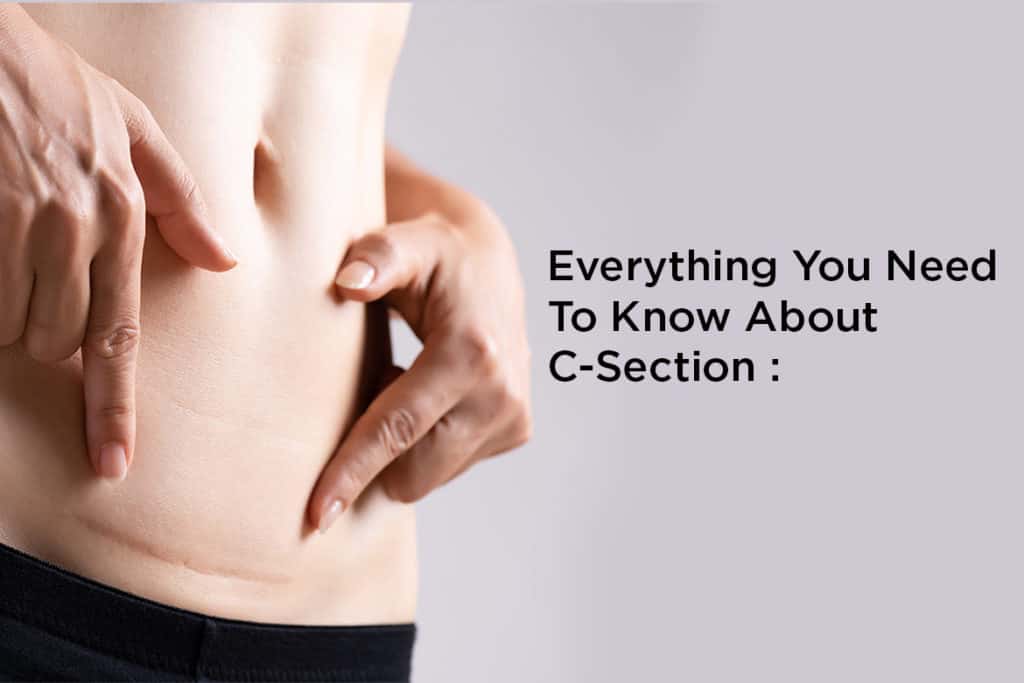
You might have imagined your childbirth multiple times, but that could be taken away at once when you are told the delivery is to take place by a cesarean or C-section. There could be many reasons to end up having a C-section, being stuck in the hospital longer, and having a tougher recovery.
Let us assure you that you are not alone in this. About 32% of babies in the United States are delivered by C-section, which is equal to about a 1 in 3 chance. Let’s take a closer look at what happens during a C-section delivery.
What is a C-section and Why Do Doctors Recommend It?
Cesarean or a C-section is a surgical delivery done through incisions in the uterus and the abdomen, typically recommended in medically necessary cases like ones with high-risk pregnancies or the baby in a breech position failing to get flipped around. A C-section can be done due to the following reasons:
A Certain Medical Condition
If you have a chronic condition like heart disease, diabetes, high blood pressure, or kidney disease you may be recommended a C-section. All of this makes a vaginal delivery quite dangerous for your body and a cesarean birth safer.
Infections
If you are HIV-positive or have an active genital herpes infection, a scheduled C-section is necessary to avoid the transmission of the infection.
The Health of The Baby
A baby suffering from an illness or a congenital condition could make vaginal delivery dangerous.
You are Having a Large Baby
Having a large baby is a condition called macrosomia, which could be dangerous for a vaginal birth.
Your Weight
If you weigh extra (gestational diabetes) or are obese, there could be a chance of you needing a C-section delivery as they tend to have longer labors, risking the operating table.
Your Age
Being older doesn’t guarantee a cesarean but has the odds of a possibility.
The Breech Position
If your baby is in a breech position, that is either feet-first or butt-first, the practitioner may decide on a C-section.
If You’re Carrying Multiple Babies
If you are having a twin pregnancy or more, you are likely to have the procedure for a C- section.
Placental Problems
A C-section is also done in case the placenta is partly or entirely blocking either the cervical opening, the placenta previa, or is separated from the uterine wall.
Any Other Complication
If you end up developing preeclampsia (pregnancy-induced high blood pressure) or eclampsia (a rare progression of preeclampsia affecting the central nervous system causing seizures), and the treatment fails to work, you will be asked to deliver via C-section to protect both of you.
Then what happens in cases that call for an unplanned C-section without the symptoms mentioned above? Normally a C-section is called for a few primary reasons that term to be an unscheduled or unplanned C-section.
These immediate reasons include:
Delayed Labor
In cases where the labor fails to start, that means the cervix isn’t dilating through the contractions post 24 or 25 hours for the first pregnancy, the doctor will call for surgery.
Labor Stalls
Pitocin or any other labor stimulator can jump-start the contractions, but if the head of the baby is too big to fit through your pelvis, a C-section is called for.
Exhaustion or a Fetal distress
In case of the mother gets exhausted or in cases of the fetal monitor picking up signs of your baby in distress, you may opt for surgery.
A Prolapsed Umbilical Cord
In cases of the umbilical cord slipping into the child’s birth canal that compresses the level of oxygen.
A Uterine Rupture
If the uterine tears, a C-section is required.
What Are The Complications and Benefits of a C-section?
While C -sections are extremely safe there can be a few things to take care of that may result in larger complications.
Complications of C-section for The Mother
- A mother could react to the medications or the anesthesia used in the procedure.
- There could be a loss of blood and an increase in the infection which is why you need to follow the doctor’s post-op care instructions.
- There can be occasional blood clots in the legs, lungs, or pelvic organs.
- The surrounding organs like the bowel or the bladder could be injured, requiring additional surgery.
- Endometritis is a rare condition where the thin lining of the uterus becomes irritated or inflamed.
Note: In case you experience any increase in pain in the pelvic area, any unusual discharge, or even a fever post-birth, call the doctor immediately.
Complications of a C-section for The Baby
- Babies from C-sections have a risk of transient tachypnea. This condition involves rapid breathing by the leftover fluid in the lungs that lasts for a day after delivery and gradually fades away.
In the case of a baby delivery under 39 weeks of pregnancy, there is a risk of breathing problems as the lungs have a chance of not developing fully. But, don’t worry, your doctor will keep a close eye on the treatment and any suspected problems while you’re in the hospital.
Benefits of a C-section
Keeping aside the rare conditions mentioned earlier, a C-section is usually quite safe, and if it seems medically necessary, it is the safest and the fastest way of getting your little one into the world and in your arms. Additionally, it is also quite healthy for you in cases of normal delivery.
- The baby will be born with a nice rounded head and not a pointy conehead newborn, resembling a tight squeeze through the vaginal canal.
- In other cases, if a C-section is done before you have pushed enough for a vaginal birth, you’ll avoid bloodshot eyes and bruises on your face.
- It also prevents the pelvic wear-and-tear that could have resulted in pain due to the episiotomy.
- Lastly, studies have shown that a C-section doesn’t impact your future fertility negatively or even limit the number of babies you can have.
The bottom line is, any delivery that makes sure of the safety and health of both the baby and the mother is the perfect and best delivery.
How Can You Recover from a C-section?
Post a C-section, you need to give yourself time and space to recover both physically and mentally which will take some time. You most probably will be asked to stay back for about 3 to 4 days in the hospital and will take at least 4 to 6 weeks at home as well before getting back into your normal routine.
Here are a few strategies for you to keep in mind for the next few weeks to come to help cope with the pain and speed recovery:
Expect Postpartum Woes
You will be dealing with the same soreness you felt at the incision site during your recovery after a C-section. These postpartum symptoms include
- Postpartum fatigue
- Sleep deprivation
- After-pains due to the contracts of the uterus
- Postpartum bleeding or discharge, also known as lochia
- Perineal pain
- Breast engorgement
- Drastic hormonal changes
So, give yourself time to rest and recover. Expect your scar to be sore for about a few weeks. So avoid holding and carrying most things except of course the little one.
Take a Break for Yourself
No, we aren’t asking you to do away with your newborn, but plan on dividing your time equally with people around you to have some time to yourself too! Reduce the household chores; we’re sure your partner would love to give you a helping hand with preparations of meals, laundry, cleaning, dishes, and of course the little one.
Monitor Your Incision
Keeping your wounds clean is of utmost importance to help speed the healing process. Ask your gynecologist how you could do so and make sure to wear loose tops and pants to avoid irritating your belly.
Be assured that the itching, pulling sensations, and numbness around the incision is normal and will pass as the time comes. However, if you end up with a fever, a lot of pain, or the wound is getting red or oozy, you must contact your practitioner as these could be a sign of an infection.
Medicate
Your doctor must have recommended a few pain-relieving drugs immediately after the surgery. So, have them, and don’t worry, they won’t pass into your colostrum.
Beware of The After Effects of C-section Meds
With the gas buildup, you may experience discomfort with added pressure on the incision and the anesthesia can slow the activity in your bowels. So avoid gassy foods, or try lying on the left side or back, drawing up your knees, holding the site of the incision, and taking deep breaths.
You May Have Constipation
Constipation is another symptom that can crop up irrespective of the childbirth experience. So, try relaxing on the toilet seat, consume some fiber-rich foods like whole-wheat bread, vegetables, and fruits, and drink plenty of fluids.
Get Yourself Nutrient-rich Foods
Have snacks and water nearby to help maintain energy and strength. Have good picks like nuts, string cheese, fiber-rich fruits, whole-wheat pretzels, baby carrots with dip, and of course bananas!
Do Your Kegels
Kegels are great for when it comes to your pelvic region, building on the pelvic floor muscles. However, also remember to avoid sex for at least four to six weeks.
That’s all folks! This is all about the reasons, complications, and benefits of having a C- section as a mode of birth. However, speaking of labor, if you need or would like to have a better understanding of the stages of labor, you can view the article curated by your very own Parenthood bliss.
To Conclude:
C-section can be a tough time and an experience, but one needs to always keep in mind the advantages too, focusing on the light at the end of the tunnel. Always remember to stay hydrated, healthy, and well-exercised, and also stay optimistic above all. You know you’ve got this and by the end, you will have your beautiful little creation in your arms. Lastly, make sure to be kind to yourself, and relax before you get into the full-steam-ahead mommyhood.
FAQs: Everything You Need To Know About C-Section:
1. How much time does it take for a C-section to take place?
2. Is it possible for a mother to opt for a C- section?
3. Why do a few doctors prefer to have a C- section?
Sources:
Reviewed By:

Esha Chainani - Obstetrician and Gynaecologist
Dr Esha Chainani is an Obstetrician, Gynaecologist and laparoscopic surgeon practicing in Mumbai. She aims to break the stigma around women’s health by advocating an inclusive and open practice of obstetrics and gynaecology. Esha is the author of several internationally published research papers and health articles in the media like the Swaddle. She founded Premaa, a non profit to reduce maternal morbidity and eventual maternal mortality by providing lower income pregnant women living in urban areas cell phone access through an app, to medically correct information proven to influence the outcomes of both mother and child. Her app Premaa pregnancy also has an entire section about contraception as well for a whole gamut of reproductive health. She has been on the panel for multiple health sessions including with the UN, USAID, BMC, gender at work and multiple non profit organisations. She’s also on the advisory panel of the South Indian medical students association. She is also an editor at the MAR Journal of Gynaecology. She advocates for accessible healthcare through her instagram account as well posting about reproductive health, mental health and sexual health.









